belt MERCEDES-BENZ GLK-Class 2013 X204 Owner's Manual
[x] Cancel search | Manufacturer: MERCEDES-BENZ, Model Year: 2013, Model line: GLK-Class, Model: MERCEDES-BENZ GLK-Class 2013 X204Pages: 378, PDF Size: 5.03 MB
Page 8 of 378

Maintenanc
e.................................. 165
Parking brake ........................ 161, 165
Warning lamp ................................. 259
Breakdown
see Flat tire
see Towing away/tow-starting
Bulbs
see Changing bulbs C
California Important notice for retail
customers and lessees ....................24
Calling up a malfunction
see Display messages
Car
see Vehicle
Care
Carpets .......................................... 310
Car wash ........................................ 304
Display ........................................... 308
Exterior lights ................................ 307
Gea rors electo rlever .................... 308
Interior ........................................... 308
Matte finish ................................... 305
Notes ............................................. 303
Paint .............................................. 305
Plastic trim .................................... 308
Power washer ................................ 304
Rea rview camera .......................... 307
Roof lining ...................................... 310
Seat bel t........................................ 309
Seat cover ..................................... 309
Sensors ......................................... 307
Steering wheel ............................... 308
Tai lpipes ....................................... 307
Trim pieces .................................... 309
Washing by hand ........................... 304
Wheels ........................................... 305
Windows ........................................ 306
Wiper blades .................................. 306
Wooden trim .................................. 309
Cargo compartment cover ...............274
Cargo compartment
enlargement ...................................... 272Cargo compartment floor
Opening/closing ............................ 277
Stowag ewell (under) ..................... 277
Cargo net
Attaching ....................................... 276
Important safety information .........275
Cargo tie down rings .........................273
Car wash (care) ................................. 304
CD player/CD changer (on-board
computer) .......................................... 222
Center console Lowe rsection .................................. 35
Uppe rsection .................................. 34
Central locking
Automatic locking (on-board
computer) ...................................... 228
Locking/unlocking (SmartKey) ........74
Changing bulbs
Cornering light function .................118
High-beam headlamps ...................118
Important safety notes ..................116
Low-beam headlamps ....................118
Overview of bul btypes .................. 117
Parking lamps ................................ 118
Reversing lamps ............................ 120
Standing lamps (front) ...................118
Turn signals (front) ......................... 119
Child-proof locks
Important safety notes ....................63
Rea rdoors ....................................... 63
Children
In the vehicle ................................... 58
Restraint systems ............................ 58
Specia lseat belt retractor ...............61
Child seat
LATCH-type (ISOFIX) child seat
anchors ............................................ 61
Top Tether ....................................... 62
Cigarette lighter ................................ 280
Cleaning Mirro rturn signal ........................... 307
Trailer tow hitch ............................. 308
Climate control
Adjusting the airflow (AIR FLOW) ...132
Automatic climate control (3-zone) 130
Controlling automatically ...............132
Cooling with aird ehumidification..131
Defrosting the windows .................1356
Index
Page 17 of 378

Program selector button
..................151
Protection of the environment General notes .................................. 22
Pulling away
Automatic transmission .................143 Q
Qualifie dspecialis tworkshop ...........27 R
Radar sensor system Activating/deactivating .................229
Display message ............................ 247
Radio
Selecting astation ......................... 222
see separate operating instructions
Reading lamp ..................................... 115
Rear compartment Setting the airflow .........................134
Setting the airv ents...................... 138
Rear fog lamp
Display message ............................ 241
Switching on/off ........................... 112
Rear view camera
Cleaning instructions .....................307
Function/notes ............................. 188
Switching on/off ........................... 189
Rear-view mirror
Anti-glare (manual )........................ 103
Dipping (automatic) .......................105
Rear window defroster
Problem (malfunction) ...................136
Switching on/off ........................... 135
Rear window wiper
Replacing the wiper blade .............. 122
Switching on/off ........................... 121
Refrigerant (air-conditioning
system)
Important safety notes ..................372
Refueling
Fuel gauge ....................................... 31
Important safety notes ..................154
Refueling proces s.......................... 155
see Fuel Remote control
Garage door opener .......................291
Programming (garage door opener) 291
Reporting safety defects ....................27
Reserve (fuel tank) see Fuel
Reserve fuel
Display message ............................ 245
Warning lamp ................................. 264
see Fuel
Residual heat (climate control) ........136
Restraint system see SRS (Supplemental Restraint
System)
Reversing feature
Panorama sliding sunroo f................ 90
Roller sunblinds ............................... 91
Side windows ................................... 86
Roadside Assistance (breakdown) ....24
Roller blind see Roller sunblind
Roller sunblind
Opening/closing .............................. 92
Panorama roof with power tilt/
sliding panel ..................................... 91
Roof carrier ........................................ 277
Roof lining and carpets (cleaning
guidelines) ......................................... 310
Roof load (maximum) ........................373
Route (navigation) see Route guidance (navigation)
Route guidance (navigation) ............221 S
Safety Childre ninthe vehicle ..................... 58
Child restraint systems ....................58
Occupant Classification System
(OCS) ............................................... 47
Overview of occupant safety
systems ........................................... 40
Safety system
see Driving safety systems
Seat belts
Adjusting the driver's and front-
passenger sea tbelt ......................... 56
Adjusting the height ......................... 56 Index
15
Page 18 of 378
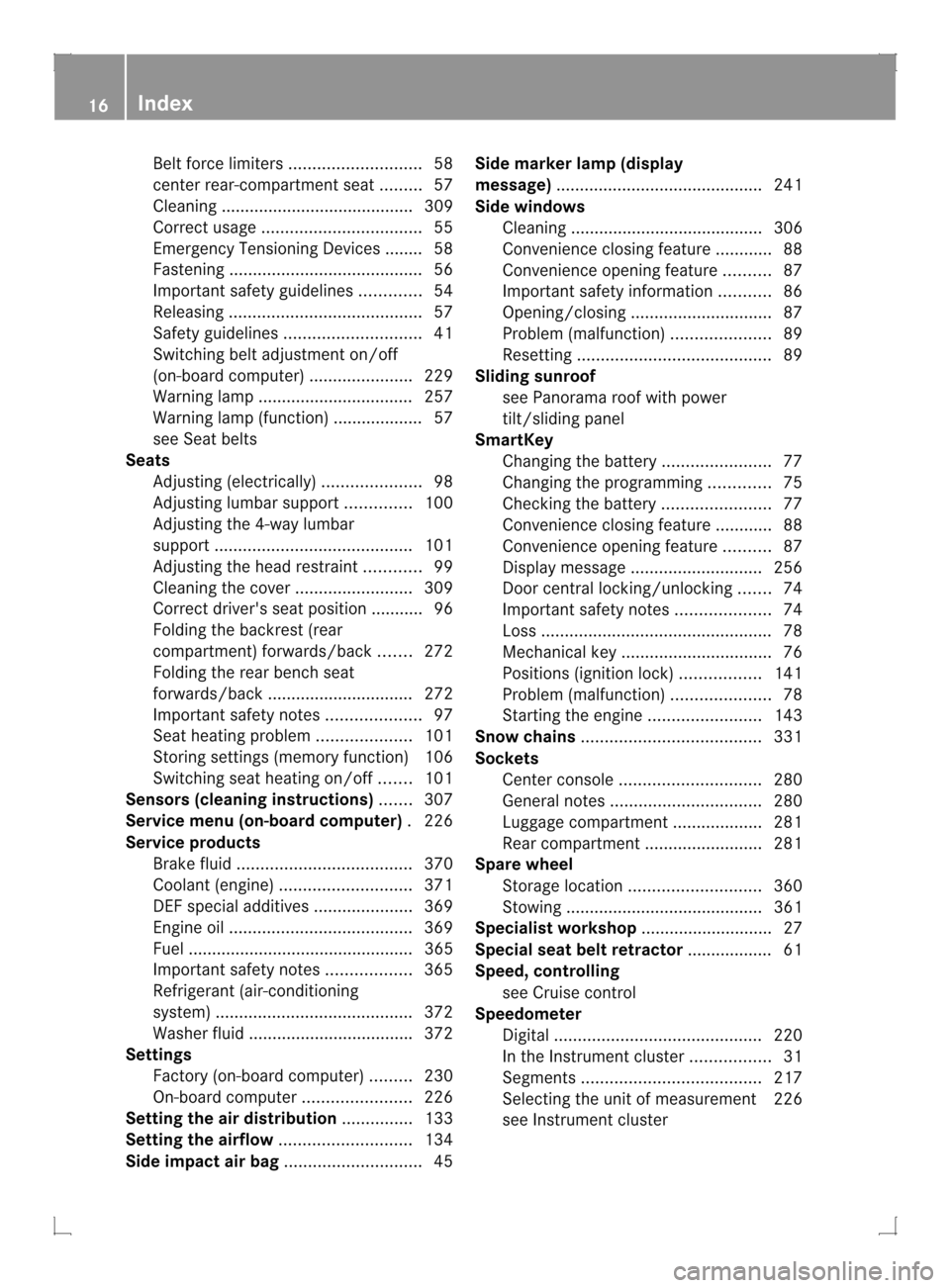
Bel
tforce limiters ............................ 58
center rear-compartment sea t......... 57
Cleaning ......................................... 309
Correct usage .................................. 55
Emergency Tensioning Devices ....... .58
Fastening ......................................... 56
Important safety guidelines .............54
Releasing ......................................... 57
Safety guidelines ............................. 41
Switching belt adjustment on/off
(on-board computer) ......................229
Warning lamp ................................. 257
Warning lamp (function) ................... 57
see Seat belts
Seats
Adjusting (electrically). ....................98
Adjusting lumba rsuppor t.............. 100
Adjusting the 4-way lumbar
support .......................................... 101
Adjusting the head restraint ............99
Cleaning the cover .........................309
Correct driver's seat position ........... 96
Folding the backres t(rear
compartment) forwards/back .......272
Folding the rear bench seat
forwards/back ............................... 272
Important safety notes ....................97
Seat heating problem ....................101
Storing settings (memory function) 106
Switching sea theating on/off .......101
Sensors (cleaning instructions) .......307
Service menu (on-board computer) .226
Service products Brake fluid ..................................... 370
Coolant (engine) ............................ 371
DEF special additive s..................... 369
Engine oil ....................................... 369
Fuel ................................................ 365
Important safety notes ..................365
Refrigerant (air-conditioning
system) .......................................... 372
Washer fluid .................................. .372
Settings
Factory (on-board computer) .........230
On-board computer .......................226
Setting the air distribution ...............133
Setting the airflow ............................134
Side impact air bag .............................45Side marker lamp (display
message)
............................................ 241
Side windows Cleaning ......................................... 306
Convenience closing feature ............88
Convenience opening feature ..........87
Important safety information ...........86
Opening/closing .............................. 87
Problem (malfunction) .....................89
Resetting ......................................... 89
Sliding sunroof
see Panorama roof with power
tilt/sliding panel
SmartKey
Changing the battery .......................77
Changing the programming .............75
Checking the battery .......................77
Convenience closing feature ............88
Convenience opening feature ..........87
Display message ............................ 256
Door central locking/unlocking .......74
Important safety notes ....................74
Loss ................................................. 78
Mechanical key ................................ 76
Positions (ignition lock) .................141
Problem (malfunction) .....................78
Starting the engine ........................143
Snow chains ...................................... 331
Sockets Center console .............................. 280
General notes ................................ 280
Luggage compartment ...................281
Rea rcompartmen t......................... 281
Spare wheel
Storage location ............................ 360
Stowing .......................................... 361
Specialist workshop ............................ 27
Special seat bel tretractor .................. 61
Speed ,controlling
see Cruise control
Speedometer
Digital ............................................ 220
In the Instrument cluster .................31
Segments ...................................... 217
Selecting the unit of measurement 226
see Instrument cluster 16
Index
Page 27 of 378
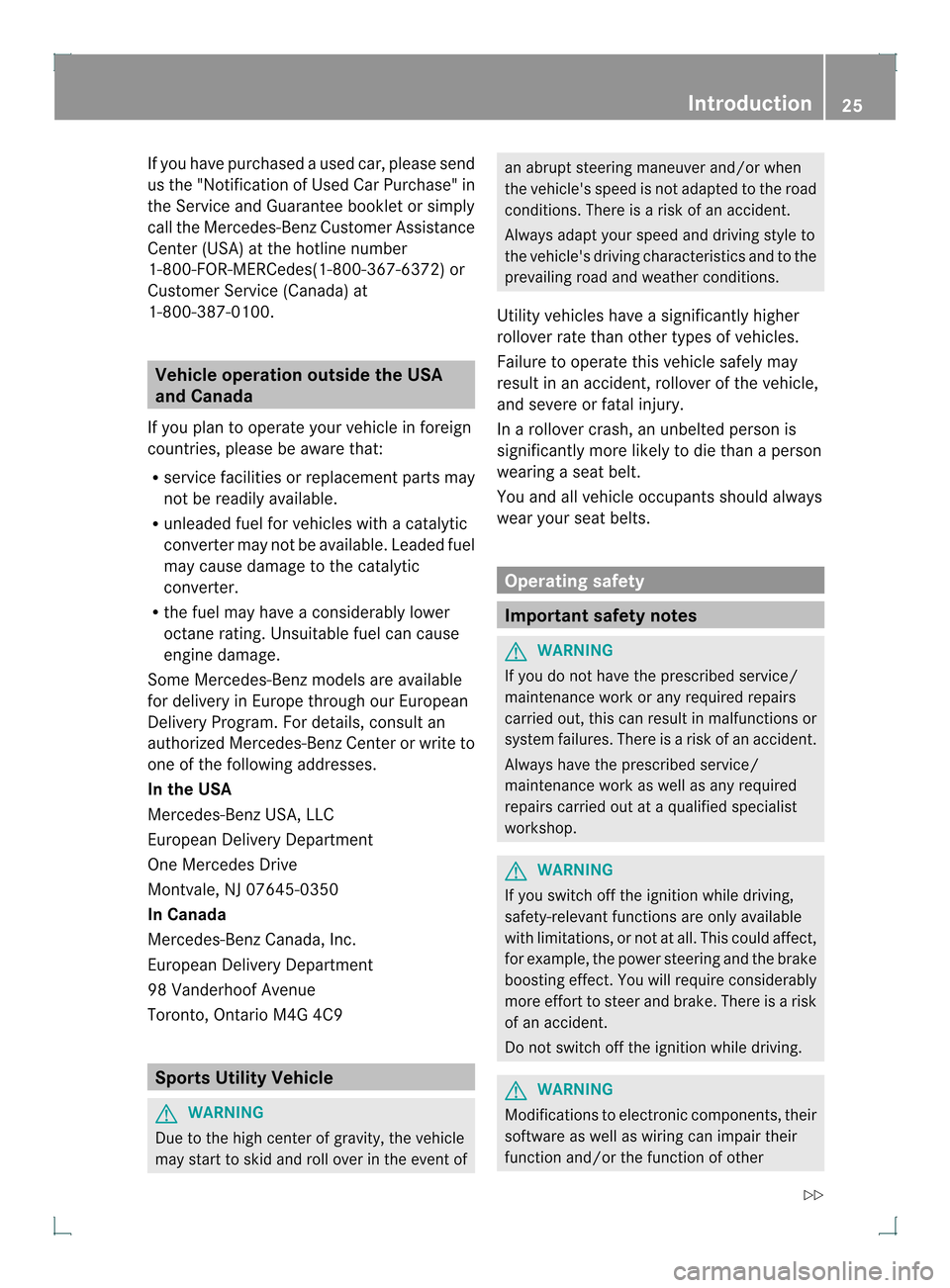
If you have purchased a used car, please send
us the "Notification of Used Car Purchase" in
the Service and Guarantee booklet or simply
call the Mercedes-Benz Customer Assistance
Center (USA) at the hotline number
1-800-FOR-MERCedes(1-800-367-6372) or
Customer Service (Canada) at
1-800-387-0100. Vehicle operation outside the USA
and Canada
If you plant o operate your vehicle in foreign
countries, please be aware that:
R service facilities or replacement parts may
not be readily available.
R unleaded fuel for vehicles with a catalytic
converter may not be available. Leaded fuel
may cause damage to the catalytic
converter.
R the fuel may have a considerably lower
octane rating. Unsuitable fuel can cause
engine damage.
Some Mercedes-Benz models are available
for delivery in Europe through our European
Delivery Program. For details, consult an
authorized Mercedes-Benz Center or write to
one of the following addresses.
In the USA
Mercedes-Benz USA, LLC
European Delivery Department
One Mercedes Drive
Montvale, NJ 07645-0350
In Canada
Mercedes-Benz Canada, Inc.
European Delivery Department
98 Vanderhoof Avenue
Toronto, Ontario M4G 4C9 Sports Utility Vehicle
G
WARNING
Due to the high center of gravity, the vehicle
may start to skid and roll over in the event of an abrupt steering maneuver and/or when
the vehicle's speed is not adapted to the road
conditions. There is a risk of an accident.
Always adapt your speed and driving style to
the vehicle's driving characteristics and to the
prevailing road and weather conditions.
Utility vehicles have a significantly higher
rollover rate than other types of vehicles.
Failure to operate this vehicle safely may
result in an accident, rollover of the vehicle,
and severe or fatal injury.
In a rollover crash, an unbelted person is
significantly more likely to die than a person
wearing a seat belt.
You and all vehicle occupant sshould always
wear your seat belts. Operating safety
Important safety notes
G
WARNING
If you do not have the prescribed service/
maintenance work or any required repairs
carried out, this can result in malfunctions or
system failures. There is a risk of an accident.
Always have the prescribed service/
maintenance work as well as any required
repairs carried out at a qualified specialist
workshop. G
WARNING
If you switch off the ignition while driving,
safety-relevant functions are only available
with limitations, or not at all. This could affect,
for example, the power steering and the brake
boosting effect.Y ou will require considerably
more effort to steer and brake. There is a risk
of an accident.
Do not switch off the ignition while driving. G
WARNING
Modifications to electronic components, their
software as well as wiring can impair their
function and/or the function of other Introduction
25 Z
Page 34 of 378
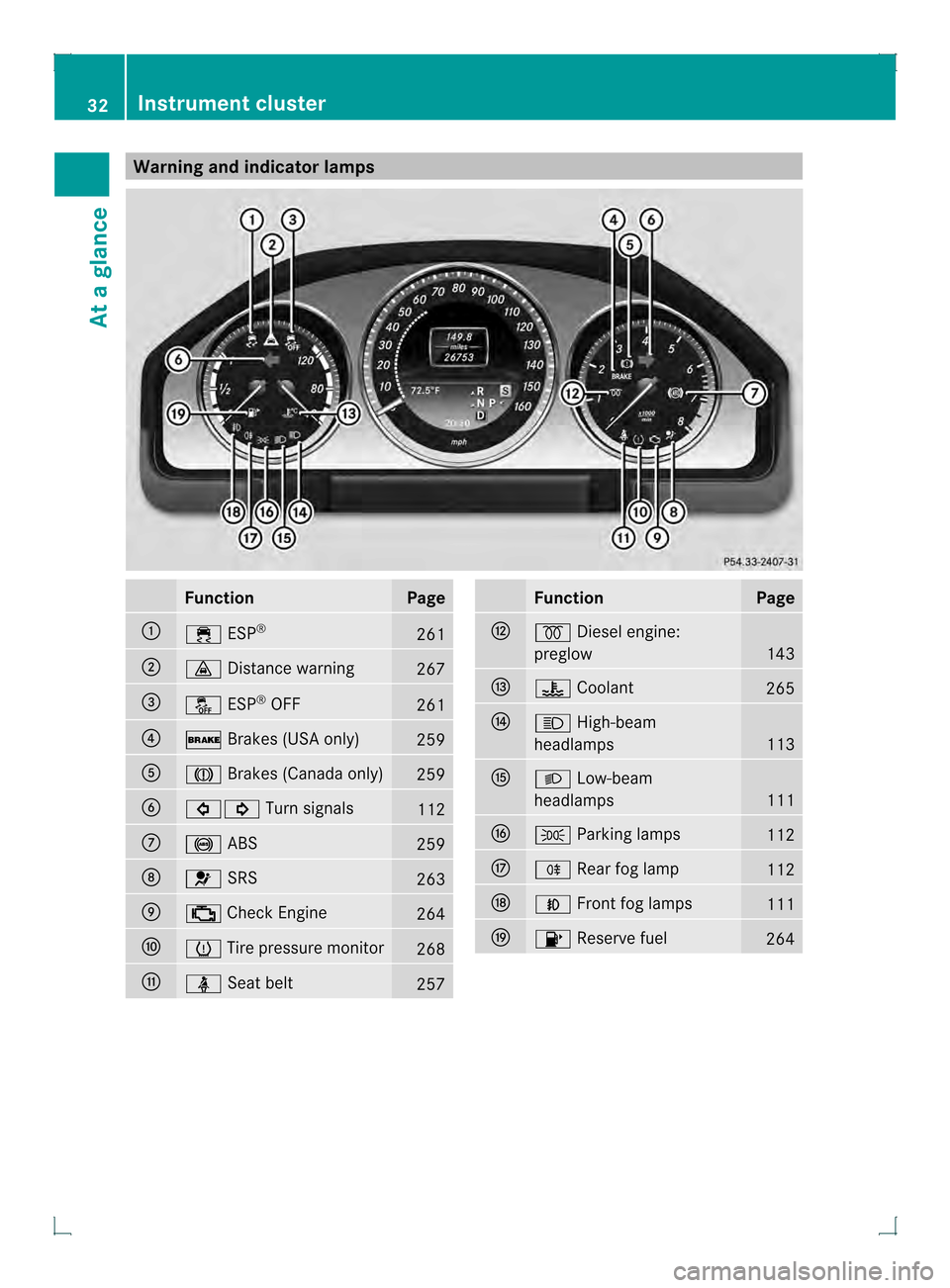
Warning and indicator lamps
Function Page
0002
000F
ESP® 261
0003
000B
Distance warning 267
0021
0017
ESP®
OFF 261
0020
000D
Brakes (USA only) 259
001E
0006
Brakes (Canada only) 259
001F
00070006
Turn signals 112
0011
001A
ABS 259
0012
0020
SRS 263
0013
000E
Check Engine 264
0014
0011
Tire pressure monitor 268
0015
0014
Seat belt 257 Function Page
0017
000C
Diesel engine:
preglow 143
0018
000C
Coolant 265
0019
000B
High-beam
headlamps 113
001A
000C
Low-beam
headlamps 111
001C
0016
Parking lamps 112
001D
0010
Rearfog lamp 112
0022
000D
Front fog lamps 111
0023
0010
Reserve fuel 26432
Instrument clusterAt a glance
Page 42 of 378

Useful information
i This Operator's Manual describes all
models and all standard and optional
equipment of your vehicle available at the
time of publication of the Operator's
Manual. Country-specific differences are
possible. Please note that your vehicle may
not be equipped with all features
described. This also applies to safety-
related systems and functions.
i Read the information on qualified
specialist workshops: (Y page 27).Panic alarm
X
To activate: press000Dbutton 0002for
approximately one second.
An alarm sounds and the exterior lighting
flashes.
X To deactivate: press000Dbutton 0002
again.
or
X Insert the SmartKey into the ignition lock.
or
X Press the KEYLESS-GO Start/Stop button.
The KEYLESS-GO key must be in the
vehicle. Occupant safety
Overview of occupant safety
In this section, you will learn the most
important facts about the restraint system
components of the vehicle.
The restraint system consists of:
R seat belts
R child restraint systems
R LATCH-type (ISOFIX) child seat anchors
Additional protection is provided by:
R SRS (Supplemental Restrain tSystem)
R NECK-PRO head restraints/NECK-PRO
luxury head restraints
R air bag system components with:
-PASSENGER AI RBAG OFF indicator lamp
- front-passenge rseat with Occupant
Classification System (OCS)
The differen tair bag systems work
independently of each other. The protective
functions of the system work in conjunction
with each other. Not all air bags are always
deployed in an accident. G
WARNING
Modifications to or work improperly
conducted on restraint system components
or their wiring, as well as tampering with
interconnected electronic systems, can lead
to the restraint systems no longer functioning
as intended.
Air bags or Emergency Tensioning Devices
(ETDs), for example, could deploy
inadvertently or fail to deploy in accidents
although the deceleration threshold for air
bag deploymen tis exceeded. Therefore,
never modify the restraint systems. Do not
tamper with electronic components or their
software.
i For information on infants and children
traveling with you in the vehicle restraint
systems for infants and children, see
"Children in the vehicle" (Y page 58).40
Occupant safetySafety
Page 43 of 378

SRS (Supplemental Restraint System)
Introduction SRS consists of:
R
The 0020 SRS warning lamp
R Air bags
R Air bag control unit (with crash sensors)
R Emergency Tensioning Devices
R Belt force limiters
SRS reduces the risk of occupants coming
into contact with the vehicle's interior in the
event of an accident. It can also reduce the
effect of the forces to which occupants are
subjected during an accident.
SRS warning lamp SRS functions are checked regularly when
you switch on the ignition and when the
engine is running. Therefore, malfunctions
can be detected in good time.
The 0020 SRS warning lamp in the instrument
cluster lights up when the ignition is switched
on. It goes out no later than a few seconds
after the engine is started.
The SRS components are in operational
readiness when the 0020SRS warning lamp
goes out while the engine is running. G
WARNING
The SRS self-chec khas detected a
malfunction if the 0020SRS indicator lamp:
R does no tlight up at all
R does not go out after approximately four
seconds after the engine is started
R comes on after the engine was started or
while driving.
For your safety, Mercedes-Ben zstrongly
recommends tha tyou have the system
checked as soon as possible at an authorized
Mercedes-Benz Center. SRS may otherwise
fail to activate when it is needed in the event
of an accident, which could lead to serious or
fatal injuries. SRS might also be activated unexpectedly and unnecessarily, which could
also result in injury.
In addition, work carried out improperly on
SRS may render SRS inoperative or cause
unintended air bag deployment. Work on the
SRS system should only be carried out by
qualified specialist personnel. Consult an
authorized Mercedes-Benz Center.
If it is necessary to modify an air bag system
to accommodate a person with disabilities,
contact an authorized Mercedes-Benz Center
for details. USA only: for further information
contact our Customer Assistance center at
1-800-FOR-MERCedes (1-800-367-6372).
Safety guidelines for seat belts,
Emergency Tensioning Devices (ETDs)
and air bags G
WARNING
R Damaged seat belts or seat belts that have
been subjected to stress in an accident
must be replaced. Their anchoring points
must also be checked. Only use seat belts
installed or supplied by an authorized
Mercedes-Benz Center.
R Air bags and pyrotechnic Emergency
Tensioning Devices (ETDs) contain
perchlorate material, which may require
special handling and regard for the
environment.C heck your national disposal
guidelines. California residents, see
www.dtsc.ca.gov/HazardousWaste/
Perchlorate/index.cfm.
R Air bags and ETDs are designed to function
on a one-time-only basis. An air bag or ETD
that has deployed must be replaced.
R Do not pass seat belts over sharp edges.
They could tear.
R Do not make any modification that could
change the effectiveness of the seat belts.
R Do not bleach or dye seat belts as this may
severely weaken them. In a crash they may
not be able to provide adequate protection.
R No modifications of any kind may be made
to any components or wiring of the SRS. Occupant safety
41Safety
Z
Page 44 of 378

R
Do not change or remove any component
or part of the SRS.
R Do not install additional trim material, seat
covers, badges, etc. ove rthe steering
wheel hub, front-passenger front air bag
cover, outer sides of the seat backrests,
door trim panels, or door frame trims.
R Do not install additional electrical/
electronic equipment on or near SRS
components and wiring.
R Keep area between air bags and occupants
free of objects (e.g. packages, purses,
umbrellas, etc.).
R Do not hang items such as coat hangers
from the coat hooks or handles over the
door. These items may be thrown around in
the vehicle and cause head and other
injuries when the window curtain air bag is
deployed.
R Air bag system components will be hot after
an air bag has inflated. Do not touch them.
R Never place your feet on the instrument
panel, dashboard, or on the seat. Always
keep both feet on the floor in front of the
seat.
R Improper repair work on the SRS creates a
risk of rendering the SRS inoperative or
causing unintended air bag deployment.
Work on the SRS must therefore only be
performed by qualified technicians.
Contact an authorized Mercedes-Benz
Center.
R For your protection and the protection of
others, when scrapping the air bag unit or
ETD, our safety instructions must be
followed. These instructions are available
from any authorized Mercedes-Benz
Center.
R Given the considerable deployment speed,
required inflation volume, and the material
of the air bags, there is the possibility of
abrasions or other, potentially more serious
injuries resulting from air bag deployment.
If you sell your vehicle, Mercedes-Benz
strongly recommends that you inform the subsequent owner that the vehicle is
equipped with SRS. Also, refer them to the
applicable section in the Operator's Manual. Air bags
Important safety notes G
WARNING
Air bags are designed to reduce the incidence
of injuries and fatalities in certain situations:
R frontal impacts (driver's and front-
passenger front air bags and driver's knee
bag)
R side impacts (side impact air bags, window
curtain air bags and pelvis air bags)
R rollover (window curtain air bags)
However, no system available today can
completely eliminate injuries and fatalities.
When the air bags are deployed, a small
amount of powder is released. The powder
generally does not constitute a health hazard
and does not indicate that there is a fire in the
vehicle. In order to prevent potential
breathing difficulties, you should leave the
vehicle as soon as it is safe to do so. If you
have any breathing difficulty but cannot get
out of the vehicle after the air bag inflates,
then get fresh air by opening a window or
door. G
WARNING
In order to reduce the potential danger of
injuries caused during the deployment of the
front air bags, the driver and front passenger
must always be correctly seated and wear
their seat belts.
For maximum protection in the event of a
collision, you must always be in the normal
seat position with your back against the
backrest. Fasten your seat belt and make sure
that it is correctly positioned on your body. 42
Occupant safetySafety
Page 45 of 378
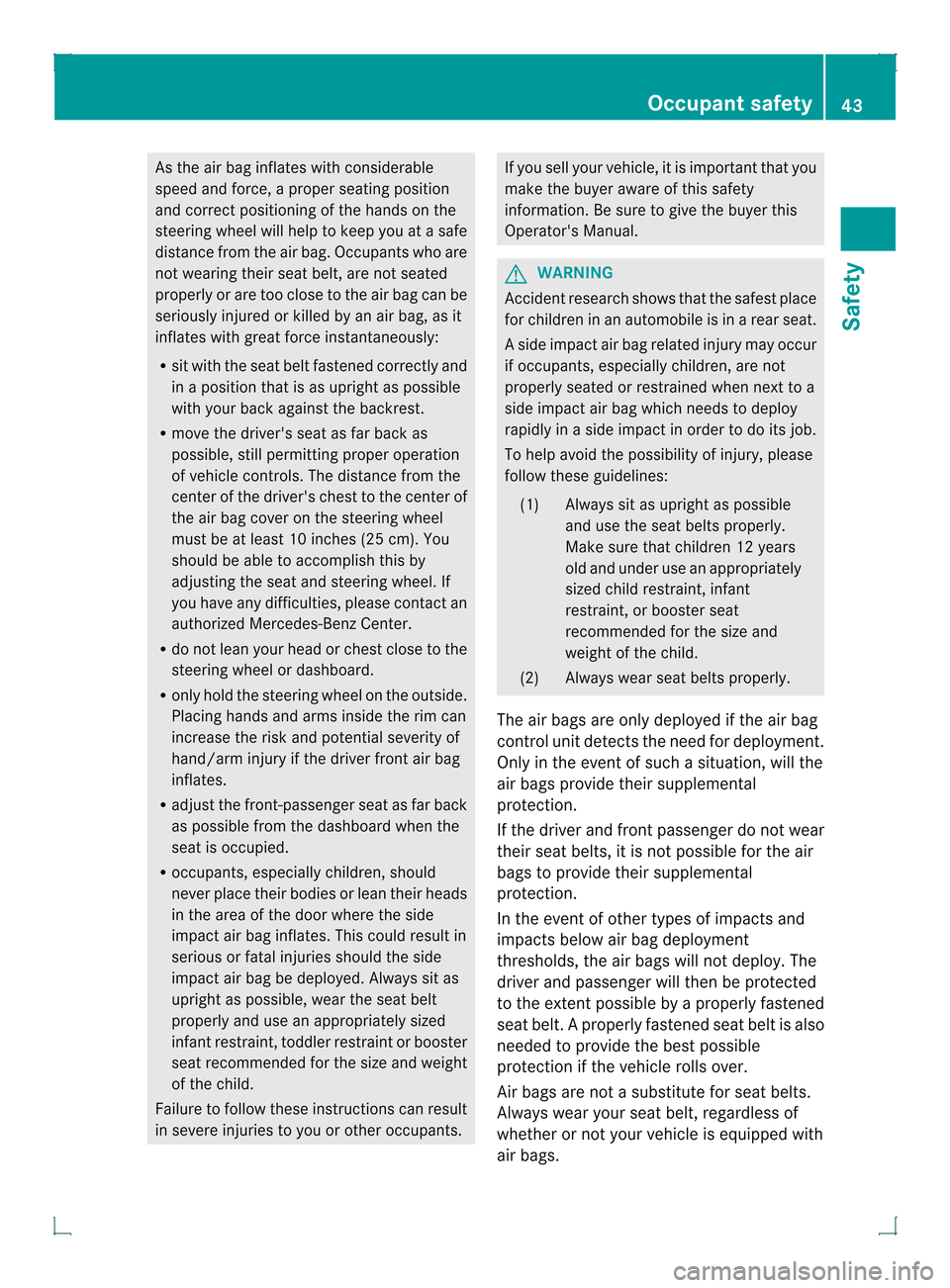
As the ai
rbag inflates with considerable
speed and force, a proper seating position
and correct positioning of the hands on the
steering wheel will help to keep you at a safe
distance from the air bag. Occupants who are
no tw earing their seat belt, are not seated
properly or are too close to the air bag can be
seriously injured or killed by an air bag, as it
inflates with great force instantaneously:
R sit with the seat belt fastened correctly and
in a position that is as upright as possible
with your back against the backrest.
R move the driver's seat as far back as
possible, still permitting proper operation
of vehicle controls. The distance from the
center of the driver's chest to the center of
the air bag cover on the steering wheel
must be at least 10 inches (25 cm). You
should be able to accomplish this by
adjusting the seat and steering wheel. If
you have any difficulties, please contact an
authorized Mercedes-Benz Center.
R do not lean your head or chest close to the
steering wheel or dashboard.
R only hold the steering wheel on the outside.
Placing hands and arms inside the rim can
increase the risk and potential severity of
hand/arm injury if the driver front air bag
inflates.
R adjust the front-passenger seat as far back
as possible from the dashboard when the
seat is occupied.
R occupants, especially children, should
never place their bodies or lean their heads
in the area of the door where the side
impact air bag inflates .This could result in
serious or fatal injuries should the side
impact air bag be deployed. Always sit as
upright as possible, wear the seat belt
properly and use an appropriately sized
infant restraint, toddler restraint or booster
seat recommended for the size and weight
of the child.
Failure to follow these instructions can result
in severe injuries to you or other occupants. If you sell your vehicle, it is important that you
make the buyer aware of this safety
information. Be sure to give the buyer this
Operator's Manual.
G
WARNING
Accident research shows that the safest place
for children in an automobile is in a rear seat.
As ide impact air bag related injury may occur
if occupants, especially children, are not
properly seated or restraine dwhen next to a
side impact air bag which needs to deploy
rapidly in a side impact in order to do its job.
To help avoid the possibility of injury, please
follow these guidelines:
(1) Always sit as upright as possible and use the seat belts properly.
Make sure that children 12 years
old and under use an appropriately
sized child restraint, infant
restraint, or booster seat
recommended for the size and
weight of the child.
(2) Always wear seat belts properly.
The air bags are only deployed if the air bag
control unit detects the need for deployment.
Only in the event of such a situation, will the
air bags provide their supplemental
protection.
If the driver and front passenger do not wear
their seat belts, it is not possible for the air
bags to provide their supplemental
protection.
In the event of other types of impacts and
impacts below air bag deployment
thresholds, the air bags will not deploy.T he
driver and passenger will then be protected
to the extentp ossible by a properly fastened
seat belt. Aproperly fastened seat belti s also
needed to provide the best possible
protection if the vehicle rolls over.
Air bags are not a substitute for seat belts.
Always wear your seat belt, regardless of
whether or not your vehicle is equipped with
air bags. Occupant safety
43Safety Z
Page 46 of 378
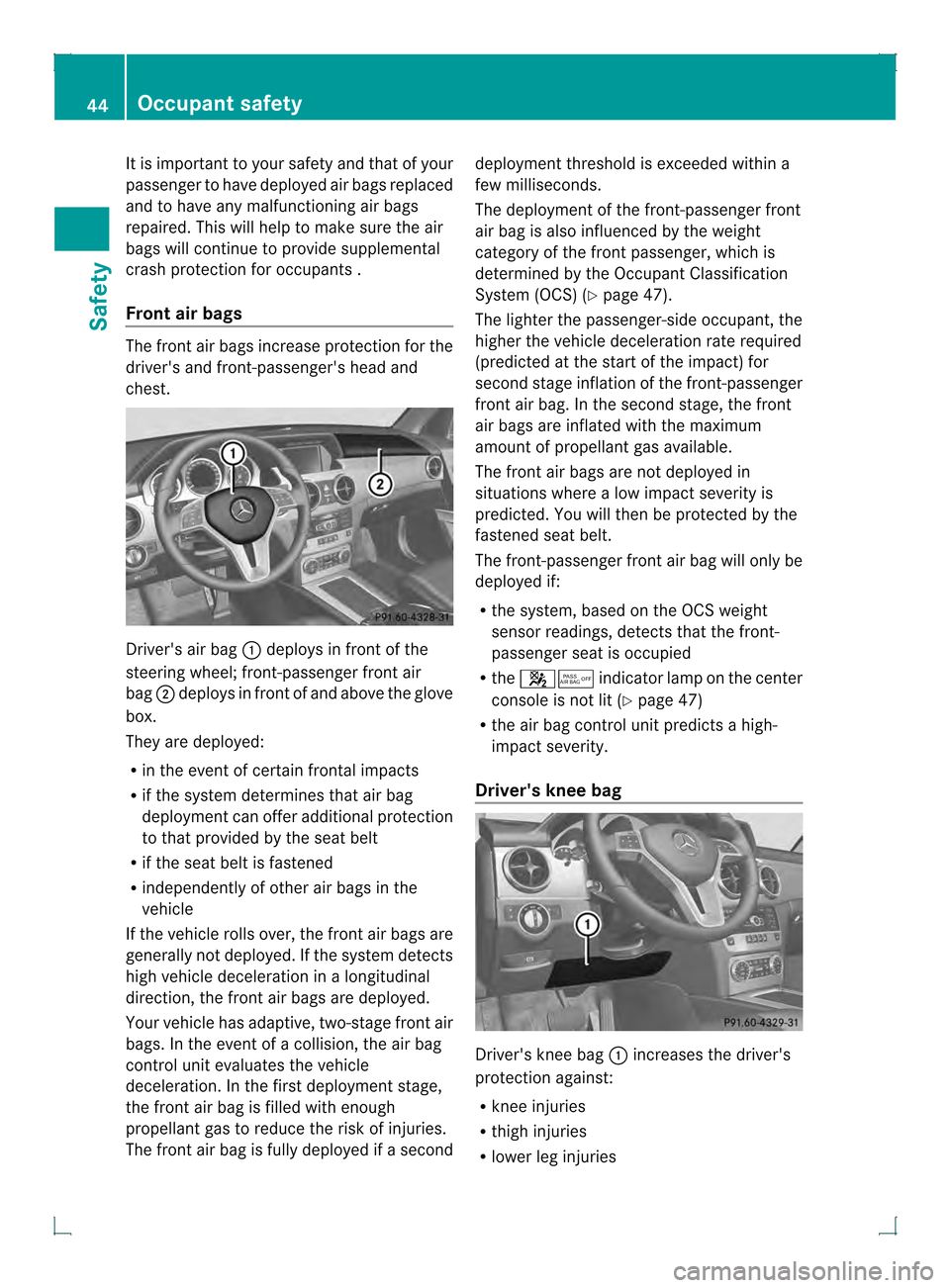
It is important to yours
afety and that of your
passenger to have deployed air bags replaced
and to have any malfunctioning air bags
repaired. This will help to make sure the air
bags will continue to provide supplemental
crash protection for occupants .
Front air bags The fron
tair bags increase protection for the
driver's and front-passenger's head and
chest. Driver's air bag
0002deploys in front of the
steering wheel; front-passenger front air
bag 0003deploys in front of and above the glove
box.
They are deployed:
R in the event of certain frontal impacts
R if the system determines that air bag
deploymen tcan offer additional protection
to that provided by the seat belt
R if the seat belt is fastened
R independently of other air bags in the
vehicle
If the vehicle rolls over, the fron tair bags are
generally not deployed. If the system detects
high vehicle deceleration in alongitudinal
direction, the front air bags are deployed.
Your vehicle has adaptive, two-stage front air
bags. In the event of a collision, the air bag
control unit evaluates the vehicle
deceleration. In the first deployment stage,
the front air bag is filled with enough
propellant gas to reduce the risk of injuries.
The front air bag is fully deployed if a second deployment threshold is exceeded within a
few milliseconds.
The deployment of the front-passenger front
air bag is also influenced by the weight
category of the front passenger, which is
determined by the Occupant Classification
System (OCS) (Y
page 47).
The lighter the passenger-side occupant, the
higher the vehicle deceleration rate required
(predicted at the start of the impact) for
second stage inflation of the front-passenger
front air bag. In the second stage, the front
air bags are inflated with the maximum
amount of propellant gas available.
The front air bags are not deployed in
situations where a low impact severity is
predicted. You will then be protected by the
fastened seat belt.
The front-passenger front air bag will only be
deployed if:
R the system, based on the OCS weight
sensor readings, detects that the front-
passenger seat is occupied
R the 001B001D indicator lamp on the center
console is not lit (Y page 47)
R the air bag control unit predicts a high-
impact severity.
Driver's knee bag Driver's knee bag
0002increases the driver's
protection against:
R knee injuries
R thigh injuries
R lower leg injuries 44
Occupant safetySafety